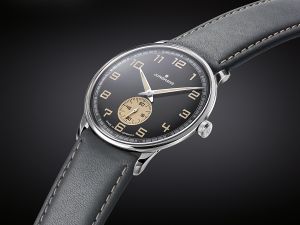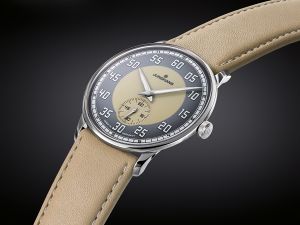Junghans Meister Driver Handaufzug - Nostalgia for the wrist
Press information
Schramberg, February 2016
Nostalgia for the wrist
Drawing its inspiration from the classic cars of the 1930s, the Meister Driver Handaufzug delivers an accomplished expression of their charm and aestheticism.
An early passion
The strong emotional link between Junghans and the motor car was first established at the end of the 19th century. Arthur Junghans, son of the company founder Erhard Junghans, was an early automobile enthusiast: in 1892 he bought one of the first Daimler test cars, which was driven to him in Schramberg by Wilhelm Maybach in person. A close friendship existed between the technically-minded Swabians Arthur Junghans, Wilhelm Maybach and Gottlieb Daimler. As a result, Schramberg regularly played host to the technical elite of the era, from Robert Bosch to Ferdinand von Zeppelin. These meetings at the villa of Arthur Junghans served to generate ideas, with these in turn producing numerous significant inventions. This passion for cars is also shared by Dr. Hans-Jochem Steim and Hannes Steim, owners of the Schramberg-based company, whose enthusiasm is manifested in their own collection of vehicles. The result is an impressive cross-section from 110 years of automobile history, including items closely associated with the history of Junghans, such as car clocks from the Schramberg factory and a "speed measuring device" developed and patented by Dr. Oskar Junghans in 1905. Selected vehicles from this collection served as models for the design of the new Meister Driver Handaufzug.
Display of enthusiasm
One design muse for the new model from Junghans is the Maybach DS 8 Zeppelin, built in 1932 – of which just 25 examples exist worldwide, finding favour with more than just car lovers. As with many vehicles from the 1930s, the car stands for highest quality finishing down to the tiniest detail, coupled with pure passion: it was a comfortable expression of exquisite luxury. Selected features of the instruments of these icons served as inspiration for the new Meister Driver Handaufzug. Both the design and the lacquer of the dial incorporate the aesthetic appearance of the original. For example, the model displays a colour combination based upon the paintwork of the classic car, already highly popular at that time: dark anthracite, cream and light grey.
An impressive charmer
The dial of the Meister Driver Handaufzug is reminiscent of a dashboard speedometer. As with the car, the harmonious proportions that characterise the appearance of the timepiece include great attention to detail. A distinctive lacquer scheme underscores the three-dimensional aspect of the domed dial and the nostalgic charm of the timepiece. In darkness in particular the large numerals and bold hands with luminous applique ensure optimal readability. Characteristic of the Junghans Meister range are the bowl-shaped inserts, in this case the small second. The discreetly-padded leather strap and contrasting stitching also reflect the affinity to the car: not only do they incorporate the interior colours of the classic vehicle, the lining leather also features the typical perforations of classic car seats. The historic parallels are also evident in the hand-winding movement: the first car clocks were also hand wound, initially with a separate key, later using the bezel, in some models. The longstanding connection between watch manufacturer Junghans and the motor car is stylishly expressed in the elegant Meister Driver Handaufzug, making it a worthy addition to the Meister collection.
Meister Driver Handaufzug – time for nostalgia
Junghans – the German watch
For more than 150 years, the Junghans brand has stood for quality, reliability and passion. Based in Schramberg, Germany, the long-established, independent company designs and manufactures watches that set new standards and are held in high regard around the world. Having close ties to the company’s location and being committed to the values that Junghans embodies, the owners work hard to maintain traditions and to move purposefully forward to a successful future. Tradition and an unswerving spirit of innovation are also reflected in the design and engineering of the company’s watches. In this regard the spectrum embraces all current watchmaking technologies: from classic mechanical watches and quartz technology all the way to the company’s own radio-controlled and solar technology. With innovative products ‘Made in Germany’ and an international outlook, Junghans will continue in future to further develop the unique success story of the watch with the star. For more information see www.junghans.de


